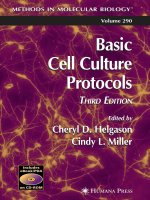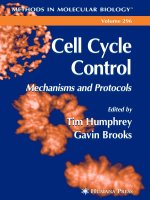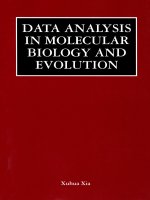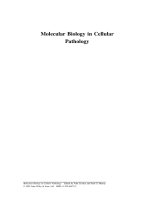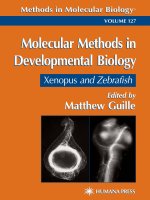molecular biology in medicinal chemistry - d. steinhilber
Bạn đang xem bản rút gọn của tài liệu. Xem và tải ngay bản đầy đủ của tài liệu tại đây (5.04 MB, 428 trang )
Molecular Biology in
Medicinal Chemistry
Edited by Th. Dingermann,
D. Steinhilber and
G. Folkers
Molecular Biology in Medicinal Chemistry. Edited by Th. Dingermann, D. Steinhilber, G. Folkers
Copyright 8 2004 WILEY-VCH Verlag GmbH & Co. KGaA, Weinheim
ISBN: 3-527-30431-2
Methods and Principles in
Medicinal Chemistry
Edited by R. Mannhold, H. Kubinyi,
G. Folkers
Editorial Board
H D. H
€
ooltje, H. Timmerman, J. Vacca,
H. van de Waterbeemd, T. Wieland
Recently Published Volumes:
G. Molema, D. K. F. Meijer (eds.)
Drug Targeting
Vol. 12
2001, ISBN 3-527-29989-0
D. Smith, D. Walker, H. van de
Waterbeemd
Pharmacokinetics and
Metabolism in Drug Design
Vol. 13
2001, ISBN 3-527-30197-6
T. Lengauer (ed.)
Bioinformatics – From Genomes
to Drugs
Vol. 14
2001, ISBN 3-527-29988-2
J. K. Seydel, M. Wiese
Drug-Membrane Interactions
Vol. 15
2002, ISBN 3-527-30427-4
O. Zerbe (ed.)
BioNMR in Drug Research
Vol. 16
2002, ISBN 3-527-30465-7
P. Carloni, F. Alber (eds.)
Quantum Medicinal Chemistry
Vol. 17
2003, ISBN 3-527-30456-8
H. van de Waterbeemd, H Lennern€as,
P. Artursson (eds.)
Drug Bioavailability
Vol. 18
2003, ISBN 3-527-30438-X
H J. B€ohm, G. Schneider (eds.)
Protein-Ligand Interactions
Vol. 19
2003, ISBN 3-527-30521-1
R. E. Babine, S. S. Abdel-Meguid (eds.)
Protein Crystallography in Drug
Discovery
Vol. 20
2003, ISBN 3-527-30678-1
Molecular Biology in Medicinal Chemistry
Edited by Th. Dingermann, D. Steinhilber and G. Folkers
Series Editors:
Prof. Dr. Raimund Mannhold
Biomedical Research Center
Molecular Drug Research Group
Heinrich-Heine-Universita
¨
t
Universita
¨
tsstraße 1
40225 Du
¨
sseldorf
Germany
Prof. Dr. Hugo Kubinyi
BASF AG Ludwigshafen
c/o Donnersbergstraße 9
67256 Weisenheim am Sand
Germany
Prof. Dr. Gerd Folkers
Department of Applied Biosciences
ETH Zu
¨
rich
Winterthurerstr. 190
8057 Zu
¨
rich
Switzerland
Volume Editors:
Prof. Dr. Theodor Dingermann
Institute of Pharmaceutical Biology
Johann Wolfgang Goethe-University
Marie-Curie-Str. 9
60439 Frankfurt
Germany
Prof. Dr. Dieter Steinhilber
Institute of Pharmaceutical Chemistry
Johann Wolfgang Goethe-University
Marie-Curie-Str. 9
60439 Frankfurt
Germany
Prof. Dr. Gerd Folkers
Department of Applied Biosciences
ETH Zu
¨
rich
Winterthurerstr. 190
8057 Zu
¨
rich
Switzerland
9 This book was carefully produced. Never-
theless, authors, editors and publisher
do not warrant the information contained
therein to be free of errors. Readers are
advised to keep in mind that statements,
data, illustrations, procedural details or
other items may inadvertently be
inaccurate.
Library of Congress Card No. applied for
British Library Cataloguing-in-Publication
Data: A catalogue record for this book is
available from the British Library
Die Deutsche Bibliothek – CIP
Cataloguing-in-Publication-Data: A
catalogue record for this publication is
available from Die Deutsche Bibliothek
( 2004 WILEY-VCH Verlag GmbH & Co.
KGaA, Weinheim
All rights reserved (including those of
translation into other languages). No part of
this book may be reproduced in any form –
by photoprinting, microfilm, or any other
means – nor transmitted or translated into
a machine language without written
permission from the publishers. Registered
names, trademarks, etc. used in this book,
even when not specifically marked as such,
are not to be considered unprotected by law.
Printed in the Federal Republic of
Germany.
Printed on acid-free paper
Typesetting: Asco Typesetters, Hong Kong
Printing: betz-druck gmbh, Darmstadt
Bookbinding: Litges & Dopf Buchbinderei
GmbH, Heppenheim
ISBN 3-527-30431-2
Contents
Preface xv
Foreword xvii
Contributors xix
Part I Molecular Targets 1
1 Cellular Assays in Drug Discovery 3
Hugo Albrecht, Daniela Brodbeck-Hummel, Michael Hoever, Beatrice Nickel and
Urs Regenass
1.1 Introduction 3
1.1.1 Positioning Cellular Assays 3
1.1.2 Impact on Drug Discovery 4
1.1.3 Classification of Cellular Assays 5
1.1.4 Progress in Tools and Technologies for Cellular Compound Profiling 7
1.2 Membrane Proteins and Fast Cellular Responses 8
1.2.1 Receptors 8
1.2.1.1 FLIPR Technology for Detection of Intracellular Calcium Release 9
1.2.1.2 Competitive Immunoassay for Detection of Intracellular cAMP 9
1.2.1.3 Enzyme Fragment Complementation (EFC) Technology 12
1.2.2 Membrane Transport Proteins 12
1.2.2.1 Ion Channels 13
1.2.2.2 MDR Proteins 16
1.3 Gene and Protein Expression Profiling in High-throughput Formats 17
1.3.1 Reporter Gene Assays in Lead Finding 17
1.3.2 Reporter Gene Assays in Lead Optimization 21
1.4 Spatio-temporal Assays and Subpopulation Analysis 24
1.4.1 Phosphorylation Stage-specific Antibodies 25
1.4.2 Target-protein-specific Antibodies 26
1.4.3 Protein–GFP Fusions 27
1.4.4 Fluorescence Resonance Energy Transfer (FRET) 29
1.4.5 GPCR Activation using Bioluminescence Resonance Energy Transfer
(BRET)
31
v
1.4.6 Protein Fragment Complementation Assays (PCA) 31
1.5 Phenotypic Assays 33
1.5.1 Proliferation/Respiration/Toxicity 33
1.5.2 Apoptosis 34
1.5.3 Differentiation 35
1.5.4 Monitoring Cell Metabolism 36
1.5.5 Other Phenotypic Assays 38
Acknowledgments 39
References 39
2 Gene Knockout Models 48
Peter Ruth and Matthias Sausbier
2.1 Introduction 48
2.2 Gene Knockout Mice 48
2.2.1 ES Cells 49
2.2.2 Targeting Vector 52
2.2.3 Selection of Recombinant ES Cells 54
2.2.4 Injection of Recombinant ES Cells into Blastocysts and Blastocyst
Transfer to Pseudopregnant Recipients
54
2.2.5 Chimeras and F1 and F2 Offspring 56
2.3 Tissue-Specific Gene Expression 59
2.3.1 Ligand-Activated CRE Recombinases 61
2.3.2 The Tetracycline/Doxycycline-Inducible Expression System 63
2.4 Transgenic Mice 65
2.5 Targeted Gene Disruption in Drosophila 67
2.6 Targeted Gene Knockdown in Zebrafish 68
2.7 Targeted Caenorhabditis Elegans Deletion Strains 70
References 71
3 Reporter Gene Assay Systems for the Investigation of G-protein-coupled
Receptors
73
Michaela C. Dinger and Annette G. Beck-Sickinger
3.1 Receptors and Cellular Communication 73
3.1.1 Ion Channel-linked Receptors 73
3.1.2 Enzyme-linked Cell-surface Receptors 74
3.1.3 GPCRs 75
3.2 Affinity and Activity of GPCR Ligands 77
3.3 The Role of Transcription Factors in Gene Expression 78
3.3.1 CREB 79
3.3.2 SRF 79
3.3.3 STAT Proteins 79
3.3.4 c-Jun 80
3.3.5 NF-AT 80
3.4 Reporter Genes 80
3.4.1 CAT 81
Contents
vi
3.4.2 b-Gal 81
3.4.3 b-Glucuronidase 82
3.4.4 AP 83
3.4.5 SEAP 83
3.4.6 b-Lactamase 83
3.4.7 Luciferase 84
3.4.8 GFP 85
3.5 Reporter Gene Assay Systems for the Investigation of GPCRs 85
3.5.1 Application of Luciferase as a Reporter Gene 86
3.5.2 Application of other Reporter Genes for the Investigation of GPCRs 88
References 91
4 From the Human Genome to New Drugs: The Potential of Orphan G-protein-
coupled Receptors
95
Remko A. Bakker and Rob Leurs
4.1 Introduction 95
4.2 GPCRs and the Human Genome 97
4.2.1 GPCR Architecture, Signaling and Drug Action 97
4.2.2 Identification of GPCRs 98
4.2.3 GPCRs in the Postgenomic Era: Orphan Receptors 99
4.3 Ligand Hunting 100
4.3.1 Reverse Pharmacology Approaches to oGPCRs 100
4.3.2 In Silico Approaches 101
4.3.3 Tissue Expression 102
4.3.4 Expression of an oGPCR of Interest 103
4.3.5 Screening Approaches 105
4.4 Screening for oGPCR Ligands using Functional Assays 106
4.4.1 GTPgS-binding Assays 106
4.4.2 Measurements of cAMP 108
4.4.3 Ca
2þ
Measurements 109
4.4.4 The Cytosensor Microphysiometer 110
4.4.5 Reporter Gene Assays 111
4.4.6 GPCR–G-protein Coupling 111
4.4.7 Ligand-independent GPCR Activity 113
4.4.8 Novel Screening Strategies 114
4.5 Future Prospects 115
References 117
Part II Synthesis 123
5 Stereoselective Synthesis with the Help of Recombinant Enzymes 125
Nagaraj N. Rao and Andreas Liese
5.1 Stereoselective Synthesis before the Advent of Genetic Engineering 125
5.2 Classical Methods of Strain Improvement for Stereoselective
Synthesis
126
Contents
vii
5.3 Genetic Engineering and the Advent of Recombinant Enzymes for
Stereoselective Synthesis
129
5.4 b-Lactam Antibiotics 132
5.4.1 Penicillins 132
5.4.2 Cephalosporins 134
5.5 Polyketide Antibiotics 137
5.6 Vitamins 140
5.6.1 L-Ascorbic Acid (Vitamin C) 140
5.6.2 Biotin (Vitamin B
8
, Vitamin H) 142
5.6.3 Riboflavin (Vitamin B
2
) 143
5.6.4 Nicotinamide (Vitamin B
3
or PP) 143
5.6.5 Vitamin B
12
144
5.6.6 D-Pantothenic Acid (Vitamin B
5
) 144
5.6.7 Vitamin A 145
5.6.8 Vitamin K (Menaquinone) 146
5.7 Steroids 146
5.8 Other Drugs 146
5.8.1 L-Dihydroxyphenyl Alanine (L-DOPA) 146
5.8.2 Crixivan
2
147
5.8.3 N-Acetyl Neuraminic Acid (NANA) 147
5.8.4 Cholesterin Biosynthesis Inhibitors (HMG-CoA Reductase
Inhibitors)
148
5.8.5 Omapatrilat 149
5.8.6 Hydromorphone 149
5.9 Concluding Remarks 150
References 150
6 Nucleic Acid Drugs 153
Joachim W. Engels and Jo
¨
rg Parsch
6.1 Introduction 153
6.2 Chemical Synthesis of Oligonucleotides 153
6.3 Chemical Modifications of Oligonucleotides 155
6.3.1 2
0
-Modifications 156
6.3.2 Alkyl- and Arylphosphonates 157
6.3.3 Phosphorothioates 159
6.3.4 N3
0
-P5
0
-phosphoramidates 160
6.3.5 Morpholino Oligonucleotides 160
6.3.6 PNAs 160
6.3.7 Sterically LNAs 161
6.3.8 Oligonucleotide Conjugates 162
6.3.8.1 5
0
-End Conjugates 162
6.3.8.2 3
0
-End Conjugates 162
6.4 Mechanism of Action 163
6.4.1 The Antisense Concept 163
6.4.1.1 Steric Blocking 163
Contents
viii
6.4.1.2 RNase H Activation 165
6.4.2 The Triplex Concept 165
6.4.3 Ribozymes 167
6.4.3.1 Structure and Reaction Mechanism 168
6.4.3.2 Triplet Specificity 169
6.4.3.3 Stabilization of Ribozymes 170
6.4.3.4 Inhibition of Gene Expression 170
6.4.3.5 Colocalization 171
6.4.4 RNAi 171
6.5 Positioning Identification of Ribozyme Accessible Sites on Target
RNA
172
6.6 Delivery 173
6.7 Application 175
6.8 Conclusion 175
References 176
Part III Analysis 179
7 Recent Trends in Enantioseparation of Chiral Drugs 181
Bezhan Chankvetadze
7.1 Introduction 181
7.2 Current Status in the Development and use of Chiral Drugs 181
7.3 The Role of Separation Techniques in Chiral Drug Development,
Investigation and Use
183
7.4 Preparation of Enantiomerically Pure Drugs 184
7.4.1 Resolution of Racemates 185
7.4.2 Chiral Pool 186
7.4.3 Catalytic Asymmetric Synthesis 187
7.4.4 Chromatographic Techniques 189
7.4.4.1 SMB 189
7.4.4.2 Other Chromatographic and Electrophoretic Techniques for
the Preparation of Enantiomers
193
7.5 Bioanalysis of Chiral Drugs 194
7.5.1 GC 195
7.5.2 HPLC 197
7.5.3 CE 198
7.5.4 CEC 203
7.6 Future Trends 204
References 205
8 Affinity Chromatography 211
Gerhard K. E. Scriba
8.1 Introduction 211
8.2 Principles of Affinity Chromatography 212
8.3 The Ligand 214
Contents
ix
8.3.1 Monospecific Ligands 215
8.3.2 Group-specific Ligands 215
8.3.3 Ligand Development 217
8.4 The Affinity Matrix 218
8.4.1 The Support Material 218
8.4.2 Immobilization of the Ligand 219
8.5 Principles of Operation 222
8.6 Modes of Affinity Chromatography 223
8.6.1 Bioaffinity Chromatography 223
8.6.2 Immunoaffinity Chromatography 224
8.6.3 Dye-ligand-affinity Chromatography 225
8.6.4 Immobilized Metal Ion-affinity Chromatography (IMAC) 225
8.6.5 Hydrophobic Interaction Chromatography (HIC) 226
8.6.6 Covalent Chromatography 228
8.6.7 Membrane Affinity Chromatography 229
8.7 Applications of Affinity Interactions 229
8.7.1 Purification of Pharmaceutical Proteins 230
8.7.1.1 Plasma Proteins 231
8.7.1.2 Recombinant Proteins 231
8.7.2 Analytical Applications 233
8.7.2.1 HPAC 234
8.7.2.2 Affinity Capillary Electrophoresis 236
8.7.2.3 Affinity Biosensors 237
References 239
9 Nuclear Magnetic Resonance-based Drug Discovery 242
Ulrich L. Gu
¨
nther, Christina Fischer and Heinz Ru
¨
terjans
9.1 Introduction 242
9.2 SAR by NMR 243
9.2.1 Sample Preparation 247
9.2.2 Quantitative Evaluation 247
9.2.2.1 Binding Affinities 247
9.2.2.2 Structure Determination from Chemical Shift Perturbations 250
9.2.3 Advanced Technologies in SAR by NMR 250
9.2.4 Data Evaluation 251
9.3 Monitoring Small Molecules 252
9.3.1 Relaxation Methods 253
9.3.2 Diffusion Methods 254
9.3.3 Methods Involving Magnetization Transfer 256
9.3.3.1 Transferred NOE (TrNOE) 256
9.3.3.2 Saturation Transfer 257
9.3.3.3 NOE Pumping 260
9.3.3.4 WaterLOGSY and ePHOGSY 261
9.3.4 Sample Preparation 262
Contents
x
9.4 Conclusions 264
Acknowledgments 264
References 265
10
13
C- and
15
N-Isotopic Labeling of Proteins 269
Christian Klammt, Frank Bernhard and Heinz Ru
¨
terjans
10.1 Introduction 269
10.2 Expression Systems for the In Vivo Incorporation of
13
C and
15
N Labels
into Proteins
270
10.2.1 Protein Production and
13
C and
15
N-labeling in E. coli Expression
Systems
271
10.2.2
13
C- and
15
N-labeling of Proteins in P. pastoris 274
10.2.3
13
C- and
15
N-labeling of Proteins by Expression in Chinese Hamster
Ovary (CHO) Cells
276
10.2.4
13
C- and
15
N-labeling of Proteins in Other Organisms 276
10.2.5 Strategies for the Production of Selectively
13
C- and
15
N-labeled
Proteins
277
10.2.5.1 Selective Labeling of Amino Acids 277
10.2.5.2 Specific Isotope Labeling with
13
C 278
10.2.5.3 Segmental Isotope Labeling 279
10.3 Cell-free Isotope Labeling 280
10.3.1 Components of Cell-free Expression Systems 281
10.3.2 Cell-free Expression Techniques 285
10.3.3 Specific Applications of the Cell-free Labeling Technique 289
References 292
11 Application of Antibody Fragments as Crystallization Enhancers 300
Carola Hunte and Cornelia Mu
¨
nke
11.1 Introduction 300
11.2 Crystallization of Membrane Proteins Mediated by Antibody
Fragments
303
11.2.1 Overview 303
11.2.2 Generation of Antibodies Suitable for Co-crystallization 306
11.2.2.1 Immunization 306
11.2.2.2 Selection of Antibodies 307
11.2.2.3 Antibody Fragments 308
11.2.3 Protein Purification and Crystallization 314
11.2.3.1 Indirect Immunoaffinity Purification 314
11.2.3.2 Crystallization 316
11.2.3.3 Alternative Approaches for Expansion of the Polar Surface 317
11.3 Conclusions 317
Acknowledgments 318
References 318
Contents
xi
Part IV Kinetics, Metabolism and Toxicology 323
12 Pharmacogenetics: The Effect of Inherited Genetic Variation on Drug
Disposition and Drug Response
325
Kurt Kesseler
12.1 General 325
12.2 Relationships between Genotype and Phenotype 326
12.3 Establishing Relations between Genotype and Phenotype 327
12.4 Phenotyping versus Genotyping – Prediction of Individual Drug
Response
329
12.5 Genetic Polymorphism in DMEs 330
12.6 Polymorphism of CYP2D6 332
12.7 Genetic Polymorphism in Drug Transporters 338
12.8 Multidrug Resistance Gene – Marker versus Functional
Polymorphism
338
12.9 Genetic Polymorphisms in Drug Targets 339
12.9.1 Cholesterol Ester Transfer Protein (CETP) Polymorphism as a Biomarker
for Response to Lipid-lowering Therapy
340
12.9.2 b
2
-Adrenergic Receptor: Predictability of Haplotype versus Single
SNPs
340
12.9.3 Polygenic Drug Target Polymorphism: Response to Clozapine
Treatment
341
12.10 Concluding Remarks 341
References 344
13 Pharmacogenomics of Bioavailability and Elimination 363
Ingolf Cascorbi and Heyo K. Kroemer
13.1 Introduction 363
13.2 Contribution of Metabolism to Drug Clearance 363
13.2.1 CYPs 363
13.2.1.1 CYP2C9 365
13.2.1.2 CYP2C19 366
13.2.1.3 CYP2D6 366
13.2.1.4 CYP3A 369
13.2.2 Phase II Enzymes 369
13.2.2.1 Arylamine N-acetyltransferases (NAT2) 369
13.2.2.2 Thiopurine-S-methyltransferase (TPMT) 370
13.3 Drug Transporters: P-glycoprotein (P-gp) 371
13.4 Conclusion 373
References 373
14 Toxicogenomics: Integration of New Molecular Biological Tools in
Toxicology
381
Wilbert H. M. Heijne, Ben van Ommen and Rob H. Stierum
14.1 Developments in Toxicology 381
Contents
xii
14.2 Functional Genomics: New Molecular Biological Tools 383
14.2.1 Genomics 383
14.2.2 Transcriptomics 383
14.2.3 Proteomics 384
14.2.4 Metabolomics 386
14.2.5 Data Processing and Bioinformatics 389
14.2.6 Biological Interpretation 390
14.3 Integration of Functional Genomics Technologies in Toxicology 392
14.3.1 Mechanism Elucidation 392
14.3.2 Transcriptomics Fingerprinting and Prediction of Toxicity 393
14.3.3 Identification of Early Markers of Toxicity 393
14.3.4 Interspecies Extrapolation 394
14.3.5 Extrapolation from In Vitro Experiments to the In Vivo Situation 394
14.3.6 Reduction of Use of Laboratory Animals 394
14.3.7 Combinatorial Toxicology 394
14.4 Illustration: The Application of Toxicogenomics to Study the Mechanism
of Bromobenzene-induced Hepatotoxicity
395
14.5 Conclusion 397
References 397
Index 399
Contents
xiii
Preface
Why address molecular biology and related technologies in a series named ‘‘Meth-
ods and Priciples in Medicinal Chemistry’’? It was the advent of the silicon chip
and the detection of DNA processing enzymes that jointly started an evolutionary
track in the 1970s which boosted the whole variety of methodologies in what is
today known as the life sciences. Also, the classical field of medicinal chemistry
has been augmented and today comprises a huge range of techniques and meth-
odologies from QSAR and structure-based design to the recently developed ‘‘high-
throughput’’ synthesis and screening. A paradigmatic change in the 1990s gave
rise to a focus on the molecular level of drug action and hence demanded the de-
velopment of appropriate biological assay technology. This is the point where the
present book starts.
In the first part, molecular targets are dealt with, going deep into cellular assay
technologies. Cell-based assays imply not only the ‘‘simple’’ detection of one cellu-
lar product, but the tracking of a variety of metabolic processes, finally resulting in
a multidimensional phenotypic characterization of cellular behavior. In a hierar-
chical step, the second chapter introduces the ‘‘gene knock-out’’ models, a tech-
nique that allows to ‘‘design’’ a disease model within a complex organism to gen-
erate a more relevant analytical tool for medicinal chemistry. The subsequent
chapter deals with a fascinating readout technology for molecular assays, the so-
called reporter genes.
The recent elucidation of the human genome has provided another boost to the
whole field. Suddenly, a huge amount of targets was available for study. The ques-
tion, however, which still remained was: What does the target do within the cellu-
lar biochemistry and how is it controlled? Those are the questions tackled in
chapter 4, which deals with orphan receptors of the GPCR type and shows the
challenges and the opportunities for finding new ligands with hitherto unknown
biological activity.
The second part of the book is devoted to synthesis. Two important fields can
benefit tremendously from molecular biology and its techniques: Stereoselec-
tive synthesis of natural compounds and of their mimics, and synthesis of DNA-
derived drugs or protein drugs. The first chapter within this section gives a
comprehensive overview about the use of enzymes in stereoselective synthesis,
emphasizing recombinant technologies, which greatly enhance the selection of
xv
working tools. The fascinating field of nucleic acid drugs, the design and synthesis,
their mimics and their mechanisms of action are the topics of chapter 6.
The third part deals with questions of analysis. Invaluable contributions have
come from use of proteins for enantioseparation and affinity chromatography. The
use of NMR and associated techniques for structure elucidation is another analyti-
cal topic to read about in this section.
Kinetics, metabolism, toxicology, and the very rapidly growing fields of pharma-
cogenomics and toxicogenomics form the contents of the final part of this book
which is unique in its presentation of today’s entanglement of the biosciences with
medicinal chemistry.
The editors are indebted to the volume editors and the authors, whose work and
motivation adds an highly important and fascinating facet to the series and grate-
fully acknowledge the ongoing support from Frank Weinreich, Wiley-VCH, during
the whole project.
September 2003 Raimund Mannhold, Du
¨
sseldorf
Hugo Kubinyi, Weisenheim am Sand
Gerd Folkers, Zu
¨
rich
Preface
xvi
Foreword
Where to start and where to end was the initial question when we selected the
subjects which should be included into a volume dealing with the application of
molecular biology in medicinal chemistry. The enormous progress in molecular
biology during the last decades has led to the development of many methods with
impact on drug discovery and drug development as well.
Modern target identification and validation on the one hand, and drug develop-
ment and characterization on the other hand require an overlapping spectrum of
methods and assays which goes far beyond the classical methodological repertoire
of medicinal chemistry. The detailed molecular characterization of interactions of
drugs with their targets is as important and demanding as detailed knowledge on
drug interactions with the entire physiological system. Concepts and assays are
available that provide us with information on drug transport, metabolism and
stability. But we also can determine and predict how a system will react upon
the application of a drug, even if this drug is considered to act very specifically at
a certain target. Methods and concepts of modern pharmacogenomics and toxi-
cogenomics have clearly demonstrated this.
Considering all this we finally decided to organize this volume in four parts: (I)
Molecular Targets, (II) Synthesis, (III) Analysis and finally (IV) Kinetics, Metabo-
lism and Toxicology.
The first chapter in part I sets the biological stage by providing an up-to-date
description of available ‘‘Cellular Assays’’ and their use and impact on ‘‘Drug Dis-
covery’’. Assays for membrane proteins and fast cellular responses, assays for gene
and protein expression profiling in high-throughput formats, spatio-temporal as-
says and subpopulation analysis as well as phenotypic assays are introduced.
More complex systems are addressed in the second chapter of part I, which deals
with gene knockout mice and techniques available for the generation of such ani-
mals.
G-protein coupled receptors are addressed in the third and fourth chapter. In the
first of these two chapters, the focus lies on the characterization of G-protein cou-
pled receptors and the application of reporter genes as read out systems, while the
subsequent chapter, as a reference to the postgenomic era, discusses strategies for
the identification of ligands for orphan G-protein coupled receptors.
Part II of the volume covers several aspects of drug synthesis. A classical overlap
xvii
between organic synthesis and biotechnology is the stereoselective synthesis of
drugs with the help of recombinant enzymes. The first chapter in this part gives an
overview on this topic and provides many examples, underscoring the impact of
such strategies.
Nucleic acid drugs eventually will come of age. Their attractiveness as potentially
very specific ligands was always in conflict with numerous pharmacokinetic prob-
lems. However, various concepts for stabilizing these molecules, the fascinating
potential of RNAi and the first approved drugs were strong reminders of these
molecules, e.g. as manipulators of cellular signaling. The chapter by Engels and
Parsch touches many aspects, including synthesis and application of this type of
compounds, including the RNAi technology.
Part III of the book focuses on analytical aspects. Enantioseparation of chiral
drugs and affinity chromatography are extremely important tools in drug devel-
opment and comprehensive reviews on these topics are presented in chapters 7
and 8.
Analytical methods related to structural biology are included in a series of three
articles. Two of these papers deal with NMR technologies that have strongly devel-
oped during the last decades. This led to the establishment of NMR as an relevant
tool for the determination also of macromolecular structures and for the detection
and characterization of ligand-target interactions. Chapters 9 and 10 summarize
the application of NMR in drug discovery and describe techniques for
13
C- and
15
N-isotopic labeling of proteins.
Rational drug design depends on exact structure knowledge, which is still best
provided by X-ray crystallography. Despite of extreme methodological improve-
ments in this field, structures of membrane receptors, which represent the most
important drug targets, are not available. A strong move towards solving this
problem might be the use of antibody fragments as crystallization enhancers. De-
tails of this exciting new technique are described in the final chapter of part III.
Pharmacogenomics and toxicogenomics are new fields with considerable impact
on future drug development. The last section of the book covers these hot topics,
which will eventually initiate the change from the ‘‘one size fits all’’ concept to the
‘‘right drug, right size, right person’’ concept.
The editors would like to gratefully acknowledge the contributions of all authors.
They also thank Dr. Frank Weinreich and Wiley-VCH for a steady support during
the ongoing project.
September 2003 Theo Dingermann, Frankfurt
Dieter Steinhilber, Frankfurt
Gerd Folkers, Zu
¨
rich
Foreword
xviii
Contributors
Dr. Hugo Albrecht
Discovery Partners Interational AG
Gewerbestrasse 16
4123 Allschwil
Switzerland
Dr. Remko A. Bakker
Leiden/Amsterdam Center for Drug Research
Department of Medicinal Chemistry
Vrije Universiteit Amsterdam
De Boelelaan 1083
1081 HV Amsterdam
The Netherlands
Prof. Dr. Annette G. Beck-Sickinger
Institute of Biochemistry
University of Leipzig
Talstrasse 33
04103 Leipzig
Germany
Dr. Frank Bernhard
Institute of Biophysical Chemistry
Johann Wolfgang Goethe-University
Marie-Curie-Strasse 9
60439 Frankfurt
Germany
Dr. Daniela Brodbeck-Hummel
Discovery Partners Interational AG
Gewerbestrasse 16
4123 Allschwil
Switzerland
Prof. Dr. Ingolf Cascorbi
Institute of Pharmacology
Ernst-Moritz-Arndt-University Greifswald
Friedrich-Loeffler-Strasse 23D
17487 Greifswald
Germany
Prof. Dr. Bezhan Chankvetadze
Institute of Pharmaceutical and Medicinal
Chemistry
University of Mu
¨
nster
Hittorfstrasse 58–62
48149 Mu
¨
nster
Germany
Dr. Michaela C. Dinger
Institute of Biochemistry
University of Leipzig
Talstrasse 33
04103 Leipzig
Germany
Prof. Dr. Theo Dingermann
Institute of Pharmaceutical Biology
Johann Wolfgang Goethe-University
Marie-Curie-Strasse 9
60439 Frankfurt
Germany
Prof. Dr. Joachim Engels
Institut of Organic Chemistry and Chemical
Biology
Johann Wolfgang Goethe-University
Marie-Curie-Strasse 11
60439 Frankfurt
Germany
Dr. Christina Fischer
Institute of Biophysical Chemistry
Johann Wolfgang Goethe-University
Marie-Curie-Str. 9
60439 Frankfurt
Germany
Prof. Dr. Gerd Folkers
Institute of Pharmaceutical Sciences
ETH Zu
¨
rich
Wintherthurerstrasse 190
xix
8057 Zu
¨
rich
Switzerland
Dr. Ulrich L. Gu
¨
nther
Institute of Biophysical Chemistry
Johann Wolfgang Goethe-University
Marie-Curie-Str. 9
60439 Frankfurt
Germany
Dr. Wilbert H. M. Heijne
TNO Food and Nutrition Research
Department of Explanatory Toxicology
Utrechtseweg 48
P.O. Box 360
3600 AJ Zeist
The Netherlands
Dr. Michael Hoever
Discovery Partners Interational AG
Gewerbestrasse 16
4123 Allschwil
Switzerland
Dr. Carola Hunte
Max-Planck-Institute of Biophysics
Department of Molecular Membrane Biology
Marie-Curie-Strasse 13–15
60439 Frankfurt
Germany
Dr. Kurt Kesseler
Industriepark Ho
¨
chst
Building H 823
65926 Frankfurt am Main
Germany
Dr. Christian Klammt
Institute of Biophysical Chemistry
Johann Wolfgang Goethe-University
Marie-Curie-Strasse 9
60439 Frankfurt
Germany
Prof. Dr. Heyo K. Kroemer
Institute of Pharmacology
Ernst-Moritz-Arndt-University Greifswald
Friedrich-Loeffler-Strasse 23D
17487 Greifswald
Germany
Prof. Dr. Rob Leurs
Leiden/Amsterdam Center for Drug Research
Department of Medicinal Chemistry
Vrije Universiteit Amsterdam
De Boelelaan 1083
1081 HV Amsterdam
The Netherlands
Dr. Andreas Liese
Institute of Biotechnology 2
Research Center Ju
¨
lich GmbH
P.O. Box 1913
52425 Ju
¨
lich
Germany
Dr. Cornelia Mu
¨
nke
Max-Planck-Institute of Biophysics
Department of Molecular Membrane Biology
Marie-Curie-Strasse 13–15
60439 Frankfurt
Germany
Dr. Beatrice Nickel
Discovery Partners Interational AG
Gewerbestrasse 16
4123 Allschwil
Switzerland
Dr. Ben van Ommen
TNO Food and Nutrition Research
Department of Explanatory Toxicology
Utrechtseweg 48
P.O. Box 360
3600 AJ Zeist
The Netherlands
Dr. Jo
¨
rg Parsch
Beilstein Chemiedaten und Software GmbH
Trakehner Strasse 7–9
60487 Frankfurt
Germany
Dr. Nagaraj Rao
Rane Rao Reshamia Laboratories Pvt. Ltd.
Plot 80, Sector 23
Turbhe
Navi Mumbai 400705
India
Dr. Urs Regenass
Discovery Partners Interational AG
Gewerbestrasse 16
4123 Allschwil
Switzerland
Prof. Dr. Heinz Ru
¨
terjans
Institute of Biophysical Chemistry
Johann Wolfgang Goethe-University
Marie-Curie-Strasse 9
60439 Frankfurt
Germany
Prof. Dr. Peter Ruth
Institute of Pharmacy
University of Tu
¨
bingen
Auf der Morgenstelle 8
Contributors
xx
72076 Tu
¨
bingen
Germany
Dr. Matthias Sausbier
Institute of Pharmacy
University of Tu
¨
bingen
Auf der Morgenstelle 8
72076 Tu
¨
bingen
Germany
Prof. Dr. Gerhard K. E. Scriba
Institute of Pharmacy
Friedrich-Schiller-University Jena
Philosophenweg 14
07743 Jena
Germany
Prof. Dr. Dieter Steinhilber
Institute of Pharmaceutical Chemistry
Johann Wolfgang Goethe-University
Marie-Curie-Strasse 9
60439 Frankfurt
Germany
Dr. Rob H. Stierum
TNO Food and Nutrition Research
Department of Explanatory Toxicology
Utrechtseweg 48
P.O. Box 360
3600 AJ Zeist
The Netherlands
Contributors
xxi
Part I
Molecular Targets
Molecular Biology in Medicinal Chemistry. Edited by Th. Dingermann, D. Steinhilber, G. Folkers
Copyright 8 2004 WILEY-VCH Verlag GmbH & Co. KGaA, Weinheim
ISBN: 3-527-30431-2
1
1
Cellular Assays in Drug Discovery
Hugo Albrecht, Daniela Brodbeck-Hummel, Michael Hoever,
Beatrice Nickel and Urs Regenass
1.1
Introduction
1.1.1
Positioning Cellular Assays
Cell-based assays allow to study the function of pharmaceutical or disease targets
within complex environments and in the overall biological context. The application
of techniques in molecular biology together with the introduction of new tools and
analytical devices has moved readouts of cellular assays from phenotypic endpoints
such as cell proliferation, cell death, respiration and functional differentiation to
the cellular analysis of functional states of specific signaling molecules and meta-
bolic components.
This transition of cellular assays from ‘‘black box’’ systems to specific target-
associated, mechanistic measurements allows the identification of chemical com-
pounds with target-specific or closely associated modulatory function. It can there-
fore be assumed that cellular assays will play an increasingly important role in
early drug discovery, in particular in discovering compounds for target validation
(‘‘chemical genetics’’; [1] for review) and in hit-to-lead selection as well as in lead
optimization. In contrast to biochemical testing of chemicals for modulatory activ-
ity on molecular targets, cellular systems can deliver additional information with
respect to drug transport, metabolism and stability. Most importantly, pharmaco-
logical targets remain in their natural environment when probed for modulation
and data should therefore have a higher predictive value (Fig. 1.1).
However, it remains to be said that, in order to use cellular assays in high
throughput, cells need to be taken out of their natural habitat and put into culture.
This will inevitably lead to alterations in the repertoire of gene and protein expres-
sion, and therefore in their phenotype. Cells used in assays should therefore be
characterized with respect to the functionality of their intracellular networks, re-
sponses to external stimuli, at least for the signaling pathway of interest, and
compared with responses and signaling events at the tissue or organ level. In many
cases this is unfortunately not yet fully possible.
Molecular Biology in Medicinal Chemistry. Edited by Th. Dingermann, D. Steinhilber, G. Folkers
Copyright 8 2004 WILEY-VCH Verlag GmbH & Co. KGaA, Weinheim
ISBN: 3-527-30431-2
3
1.1.2
Impact on Drug Discovery
Many compounds are lost during the discovery and development process due to
undesirable effects or toxicity and lack of required efficacy. A large part of these
effects can be related to interactions of the potential drug with targets other than
the one initially selected to modulate disease. Cellular test systems have the po-
tential to elucidate the multiplicity of interactions of drugs, and therefore contrib-
ute to a better understanding of drug action and drug selection.
The cell is organized in metabolic and signal transduction cascades. Most of
these cascades are complex and nonlinear [2]. In addition, different cascades com-
municate with each other, and form intracellular circuits and domains. Most dis-
eases cannot be explained by one altered step in a pathway, but are due to several
alterations that affect networks in a complex way [3, 4]. Similarly, drugs, whether
they interact specifically with one single target or with several molecules, will dis-
turb signaling and metabolic cascades in a complex fashion. In addition, since
Identification
of potential
targets
Assay
Development
Hit
Finding
Lead
Finding
Tight target coupled
cellular assays
Target validation
Disease linkage, Functional studies, Chemogenomic
s
Lead driven
Ta
rget selection
Lead
Optimizat
ion
Drug Candidate
Selection
•Tight target coupled assays
•Phenotypic assays
•Loose target coupled or
uncoupled assays: Systems
effects
•
Intracellular pharmacology
Tight target coupled
and phenotypic
cellular assays
Fig. 1.1 Chemistry-driven target selection. The
increased number of potential pharmaceuti-
cal targets emerging from the functional
annotation of the human genome requires an
efficient process to select those that are valid
for modulating disease-relevant pathways and
phenotypes. Cellular assays which are tightly
coupled in the readout with the target of
interest allow us to qualify the hits identified in
cellular or biochemical high-throughput assays
with respect to functionality in a physiologically
relevant environment. Cellular assays which are
not tightly coupled to the target will indicate
system effects of compounds and can be
interpreted as a cellular ‘‘safety ’’ classification.
Cellular assays can be used for target and
compound prioritization.
1 Cellular Assays in Drug Discovery
4
many cell types make use of the same types of signaling molecules, in a different
context, many cell types might be affected to different extents by the same drug.
The recent introduction of high-content screening, high-throughput gene and pro-
tein expression, as well as metabolite analysis [5, 6], offers the possibility to study
system interactions in a multiparallel fashion, and allows a better understanding of
the degree and location of interference. Cell-based assays therefore provide a solu-
tion to study the modulation of a pharmaceutical target within its complex natural
network as well as to assess potential effects on other networks.
Human diseases are characterized by one or several alterations in metabolic and
signaling pathways important to maintain cellular homeostasis and the differ-
entiated functions. Cellular assays can offer a representation of such alterations
and therefore become relevant functional models to assess drug action.
Nowadays, cellular assays offer the opportunity to identify the intervention
points that lead to phenotypic or endpoint alterations. Often, multiple intervention
sites are necessary to alter the outcome of biological networks. Similar rules might
apply for the number of drug targets that need to be modulated; in particular, for
complex diseases. The right targets and drug combinations can be selected only in
the case where each single component of a particular pathway can be individually
studied, and this is only rendered possible by the use of cellular systems.
The combination of compound that lead to the desired endpoint can be iden-
tified by analyzing multiple parameters. The analysis can, moreover, facilitate the
assessment of the effect of individual compounds on multiple pathways. This can
be taken as a measure for ‘‘unwanted effects’’ (safety profile), but can also lead to
the identification of applications in new indications. The analysis of targeted and
focused chemical libraries in cellular systems may allow a rapid selection of com-
pounds with various and desired profiles.
Hierarchical, spatio-temporal readouts will generate system-level insight into
mechanisms of drug action (intracellular pharmacology) and allow us to predict
systemic effects (Fig. 1.2). The development and application of computational tools
as well as models of intracellular pathways are a prerequisite to secure data evalu-
ation and interpretation [7, 8]. System-level understanding is only possible by
seeking experimental results at the cellular level or beyond.
The recent developments of cellular high-throughput systems, which allow spe-
cific measurements of molecular events, render applications in primary screening,
and in hit-to-lead selection and lead optimization, in particular, possible. This will
enable the development of structure–activity relationships at the system level as a
new paradigm in compound selection and decision-making.
1.1.3
Classification of Cellular Assays
Cellular assays have the advantage that the pharmacological targets do not need to
be purified. However, in many instances, cellular assays require cell manipulation
to allow for a specific signal readout. Overexpression of cell-surface receptors
or intracellular proteins can have a substantial effect on the cell physiology and
1.1 Introduction
5
have to be taken into account when using the systems for the discovery of novel
drugs.
Early reactions to hormones, growth factors and neurotransmitters are often
mediated via second-messenger systems or rapid influx and efflux of ions. Post-
translational protein modifications and translocation of proteins are the next steps
that alter the physiological state of cells. Such changes are able to lead to flow
changes in metabolic pathways, and to alterations in gene and protein expression,
ultimately leading to new cellular phenotypes, including cell proliferation and cell
death.
Cellular assays can be classified by the temporal events occurring when a cell is
exposed to alterations in the extra- and intracellular environment (Tab. 1.1). Fast
responses indicated by changes in ion or second-messenger concentrations ulti-
mately lead to functional and phenotypic changes.
Some of the cellular events can be recapitulated in so-called model systems,
which might be easier to handle and to manipulate genetically than mammalian
cells. Yeast has turned out to be an organism of choice, where metabolic signals
and protein–protein interactions relevant for signal transduction can be translated
Extracellular
space
Cytoplasm
with
Organelles
Proteins
+++ +++
m RNA
• Receptors
• Transporters
• Ion channels
•pH
•pO
2
Translocstions
Receptor ligands
Proteins
Phosphorylation
Ions, metabolites
fast response
medium response
slow response
Sensors
Legend
Nucleus with
DNA and transcription
machinery
Fig. 1.2 Schematic cellular circuit and cell
systems analysis concept. Cells connect to
their environment with a wealth of receptors,
channels and transporters. Intracellular
signaling and metabolic pathways and
networks react to intra- and extracellular
stimuli in a spatio-temporal manner. Different
cell types can react differently to the same
stimuli. It can be envisaged that different cell
types, cells from normal or pathological tissue,
or genetically manipulated cells, can be
exposed to different stimuli with and without
drugs and the cellular reaction can be assessed
by sensor systems in a spatio-temporal
fashion, from fast responses to phenotypic
changes. Multiparametric analysis will identify
compounds with target-specific, target-
unrelated, reversible or irreversible effects on
cellular homeostasis.
1 Cellular Assays in Drug Discovery
6


